MENU
MENU
Tea production area: Niyodogawa Town, Tsuno Town, Shimanto Town, Otoyo Town, Sakawa Town, etc.
Brand: Tosa tea, Goishi-cha, Ikegawa tea, Tsunoyama tea, Shimanto Tea, Niyodo tea, Sawatari tea
Types of tea: Sencha (medium steamed green tea), dark tea (post-fermentation tea), hojicha, bancha, black tea, etc.
Tosa tea
Tosa tea is made 100% from tea leaves cultivated in Kochi Prefecture. Tosa is the old name of Kochi Prefecture. About 80% of tea fields in Kochi Perfecter are located on the slope of the mountains.
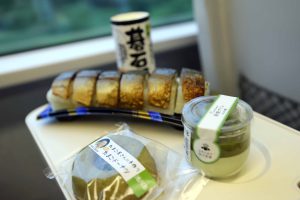
Sweets using Ikegawa tea (August 2019)
Goishi-cha (Goishi tea)
Goishi-cha is post-fermented tea made in Otoyo Town. Otoyo Town is located in a mountainous area in the middle of the Shikoku Region.
Goishi-cha is produced with a two-stage fermentation. The first fermentation is an aerobic fermentation using mold and the second fermentation is an anaerobic fermentation using lactic acid bacteria.
Tradition says that Goishi-cha was introduced to the Shikoku Region from the mountainous area of Southeast Asia or Yunnan Province, China.
Goishi-cha was a special product of the Tosa Domain from the Edo Period to the Meiji Period (1868-1912). When the Showa Period (from 1926) began, the number of producers decreased due to depopulation and the aging of producers.
The only producer became the Ogasawara family from around 1975. Otoyo-Goishi-cha-kyodokumiai (大豊碁石茶共同組合) is a cooperative association for Goishi-cha which was established in 2010 in order to keep Goishi-cha from dying out.
In 2018, Goishi-cha, Awa bancha, and Ishizuchikuro-cha were designated as “recordable folk cultural property” for their fermented tea producing technology in the Shikoku Region.
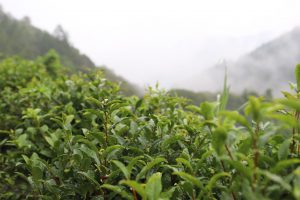
Tea plants for Goishi-cha in Otoyo Town (August 2019)
The method of producing Goishi-cha
1. Branches of tea plants with leaves are plucked from the middle of June until the beginning of August. These are steamed in a large caldron for about 2 hours.
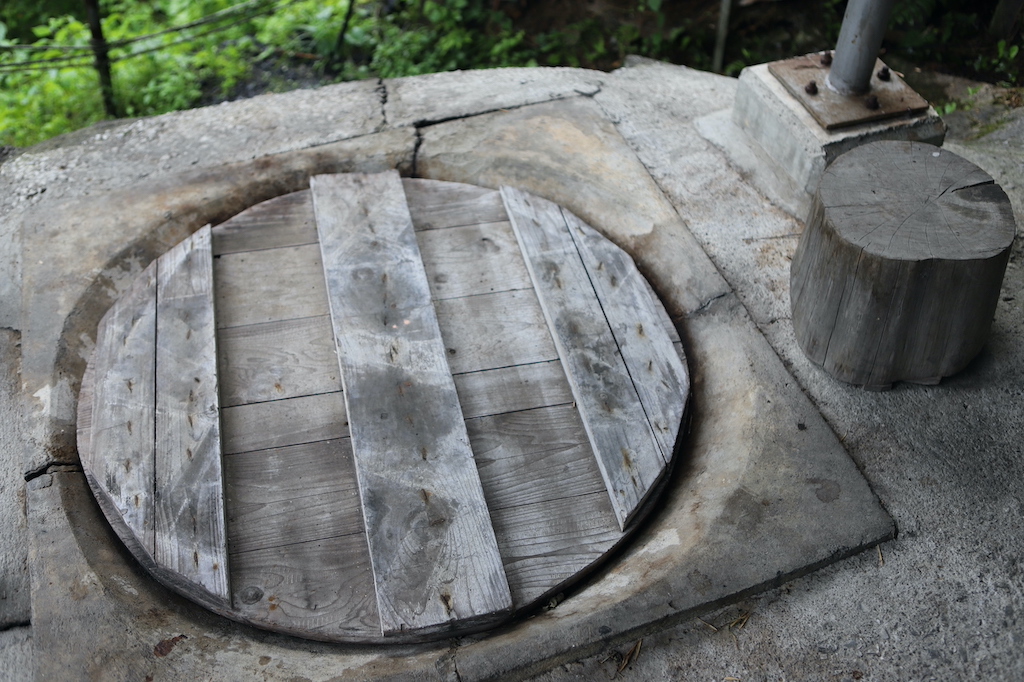
A large caldron
2. After removing the tea leaves from the branches they are put in a chamber and placed on a straw mat for about 1 week. Aerobic fermentation is then carried out by adding mold as the first fermentation. Sometimes, the tea leaves are thrown up into the air by hand to make space between the leaves. This is important because it promotes the fermentation.
3. The leaves are then soaked in a wooden bucket with the broth which was made from steaming the leaves. A lid is put on the tea leaves and place a cement block or stones on the lid for about 2 weeks so anaerobic fermentation is carried out with lactic acid bacteria as the second fermentation.
4. The tea leaves are later removed from the bucket and cut into 3 to 4 cm square piece using a special knife. These pieces are dried in the sun for 7 consecutive sunny days.
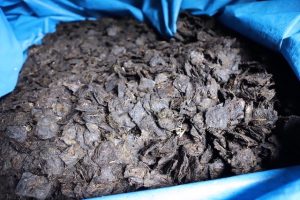
Cut tea leaves of Goishi-cha before sun-drying (August 2019)
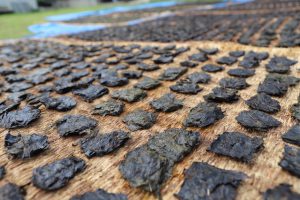
The cut leaves during sun-drying in Otoyo Town (August 2019)
The origin of name of Goishi-cha
It is said that when laying the cut tea leaves on a straw mat they look like Go-stones (碁石) on a Go-board (碁盤) and thus the tea was named Goishi-cha.
Go (碁) is an Asian board game.
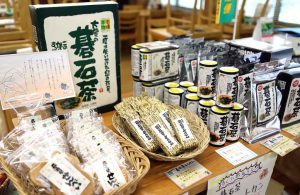
Goishi-cha and sweets using Goishi-cha at Michinoeki Osugi (August 2019)
How to drink Goishi-cha
Goishi-cha has a sharp sour acidic flavor. 1 or 2 pieces of Goishi-cha is boiled with about 1 to 1.5 liters of water in a kettle or pan for 10 minutes.
Drinking Goishi-cha with a sweet lactic fermentation drink is also a good way to enjoy it.
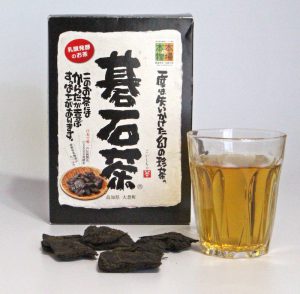
Goishi-cha 碁石茶
Bancha (番茶・晩茶):
Originally bancha means coarse tea in contrast with sencha (medium-steamed green tea). Sencha is produced with new tender tea leaves which plucked in the first tea season in Japan. Bancha is produced with matured hard tea leaves and stems plucked in the late season of the first tea season or in autumn. Shuto bancha means steamed green tea produced with tea leaves plucked in the autumn and early winter.
Related article on the site:
Tea related facility: 大豊碁石茶共同組合、碁石茶博物館
Tea mascot Yuru-Chara:
Ceramic and pottery art:
Reference:
松下智 (平成3年) 日本名茶紀行 (初版) 雄山閣出版
中村洋一郎(平成22年) 中村洋一郎のお茶しませんか 羽衣出版
高野實・谷本陽蔵・富田勲・中川致之・岩浅潔・寺本益英・山田新市 (2005) 緑茶の事典 (改訂3版) 柴田書店
大森正司、阿南豊正、伊勢村護、加藤みゆき、滝口明子、中村羊一郎編(2017) 茶の事典 初版第一刷 朝倉書店
大豊町碁石茶協同組合 http://514.or.jp
高知県 土佐茶に関すること
http://www.pref.kochi.lg.jp/soshiki/160701/2019062600125.html
土佐茶プロジェクト http://www.tosacha-pj.jp
津野ぶら 津野山茶のおいしい楽しみ方
https://town.kochi-tsuno.lg.jp/tsunobura/tea.html
霧山茶 http://www.kiricha.com
文化庁 報道発表 平成30年1月19日 文化審議会答申(重要無形民俗文化財の指定等)
https://www.bunka.go.jp/
https://www.bunka.go.jp/koho_hodo_oshirase/hodohappyo/__icsFiles/afieldfile/2018/01/18/a1400149_01.pdf
*When visiting the shops and facilities introduced in this article, please check the business hours on their website, etc. before visiting.
*The information provided on this site may be updated. If you find any information in this article that is incorrect, new, or incomplete, please contact CHAMART.
*The site does not describe all “Teas of Japan” or all “Teas of the World”. Additionally, each article expresses the writer’s personal experience and feelings.
#goishicha #goishicha #goishitea #kochi